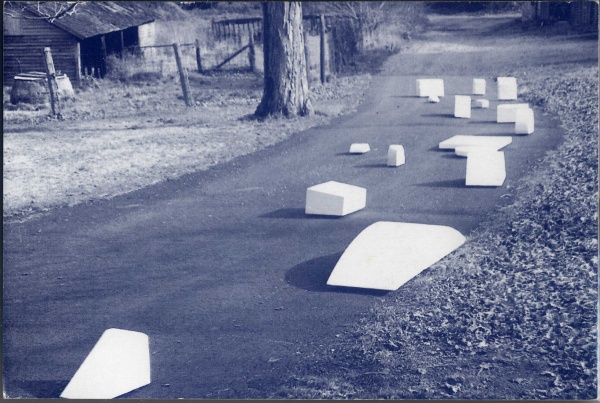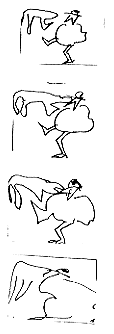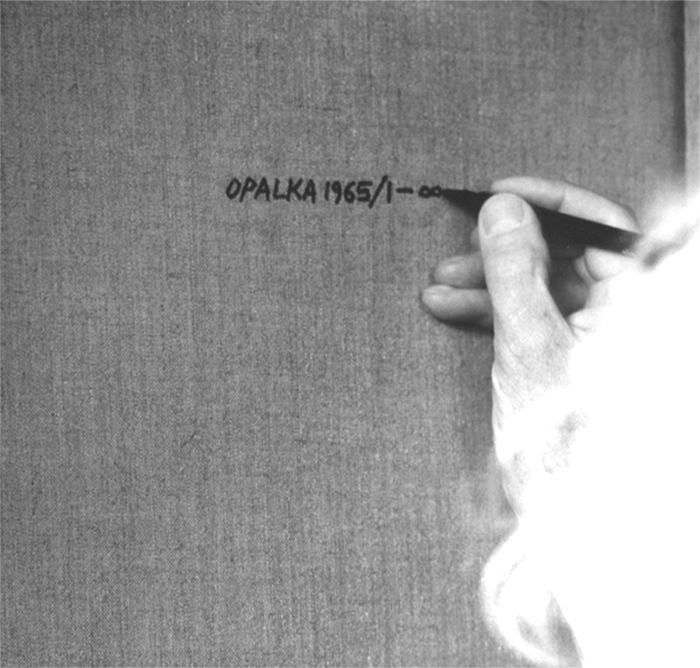Aug 20, 2011
Counting Down, Counting Across: Roman Opalka and Robert Breer
Roman Opalka and Robert Breer died within a week of each other1 . Both artists broke time into discrete pieces and then put it together again. One number per unit of time, Opalka’s increments slip from one to the next almost imperceptibly, using the notation of numbers to differentiate and link one to another. Breer’s fragments were originally drawn on index cards. Sometimes the images skip across the screen erratically but at other times, as in conventional animation, he edits them so that they create an illusion of continuous movement.

Opalka started counting in 1965 and never stopped until he died. Like another of his contemporaries, On Kawara, his work, once the premise had been established, composed itself. The subject never changed. All the artist had to do was to execute according to a strict schedule. A day could not be missed because the continuity of barely perceptible increments could not be broken. Wherever the artist was and whatever he might be doing the count of days or numbers had to be enacted. When Opalka could not make paintings, for instance when he was travelling, he made drawings.

Breer, in addition to the animations he is most known for, made box or pillar-like sculptures, called ‘floats’, that sit on the ground or floor and powered by tiny motors, move with imperceptible slowness. About six years ago he was seen accompanied by one of these sculptures, presenting some of his films. He gave a short talk before the screening. The box was on the floor close to him. Breer did not tell the audience what to expect. After the screening, which lasted about an hour, he came back on stage to talk a little more. The box had rotated about 30 degrees and had shifted about two feet across the floor.

Ingenuity has something to do with the way both artists went about their work. Not all artists are ingenious, some are simply crazy or loud or persistent. Opalka devised a devilishly simple method of generating meaning and beauty, and now that he’s laid claim to it, it appears that no-one else can employ the same method without appearing abjectly plagiaristic or naively unaware of recent art history. Opalka’s body of work is a self-portrait that casts a long shadow. By definition a self-portrait of Opalka can only be made by himself. When someone else employs this method of making art the result often awkwardly resembles an impersonation of Opalka doing a self-portrait.

I’m not sure there is a clear beginning and end to Breer’s pieces, at least there doesn’t seem to be a definite end other than the boundary of the reel or the power in the battery of the sculpture, both of which are kind of necessary but arbitrary limits. The animations often loop back to something from the beginning. The sculptures wander with no destination in mind. The stills or ‘frames’ that make up the films do, in a sense, count down at 24 frames per second, from the first image to the last, but don’t they also count ‘across’ time in a lateral sense?
Opalka’s numbers have a well defined beginning and end. Seen as a posthumous whole, the series of paintings from the most recent number to the first, counts down from his departure. But visually, where Breer’s images count down (vertically through the projector), looking at Opalka’s numbers the eye moves across from the left to the right as it counts and then at the edge, in the strange movement unique to reading, suddenly veers down in the opposite direction from right to left. And, as if you weren’t supposed to notice, the eye catches the next number from the left side of the line below.
References
- Opalka on August 6th, 2011, Breer five days later. [↩]
- Roman Opalka, (from the 1965 / 1 – ∞ series), synthetic polymer paint on canvas, 196 cm x 135 cm, 1965. [↩]
- Photo: Frances Breer. Courtesy: Robert Breer and gb agency, Paris, From Mousse magazine, Robert Breer and BigMinis at CAPC, Bordeaux, November 30, 2010 [↩]
- Author’s sketches of frames from Robert Breer’s A Man and His Dog Out For Air
Courtesy of Robert Breer, From Robert Breer: Animator, by Jackie Leger
[↩] - Roman Opalka [↩]